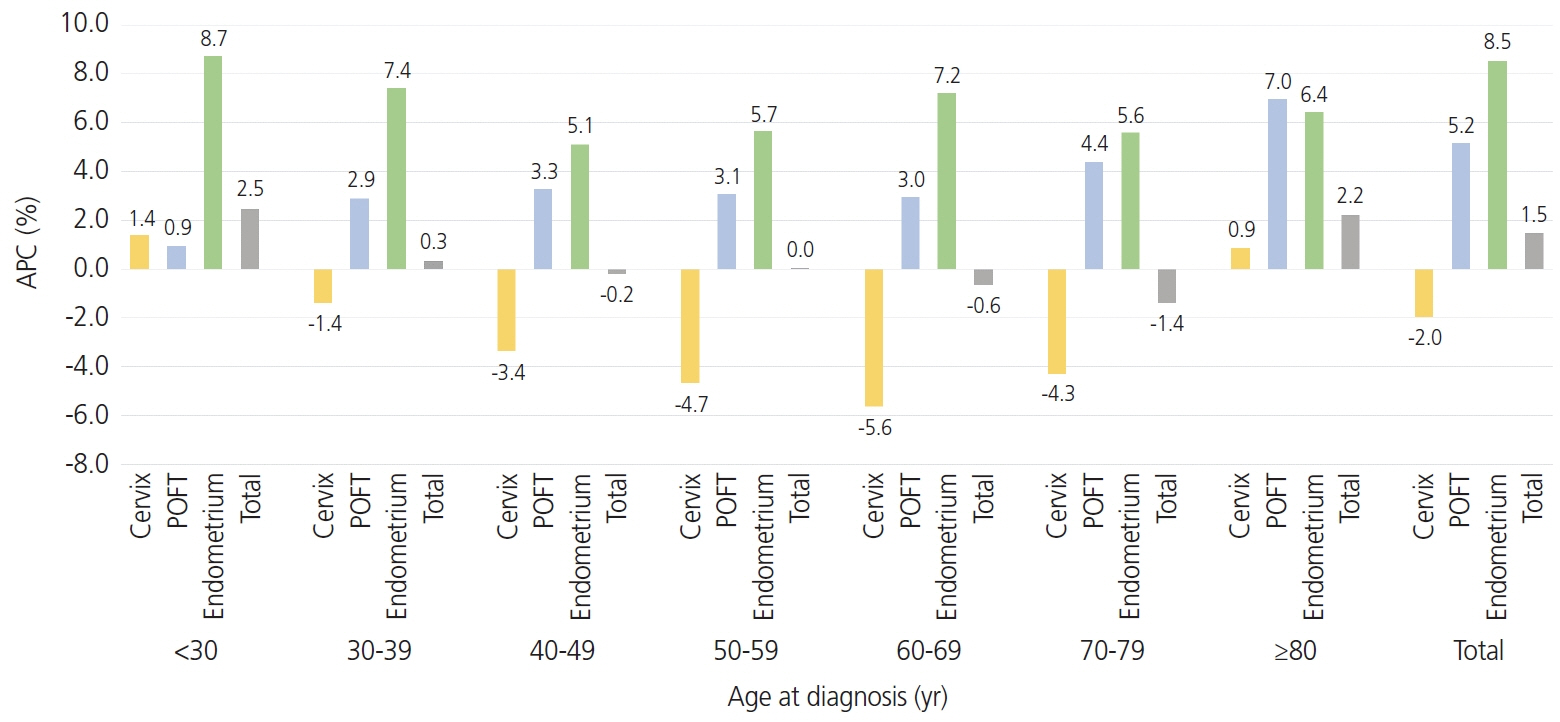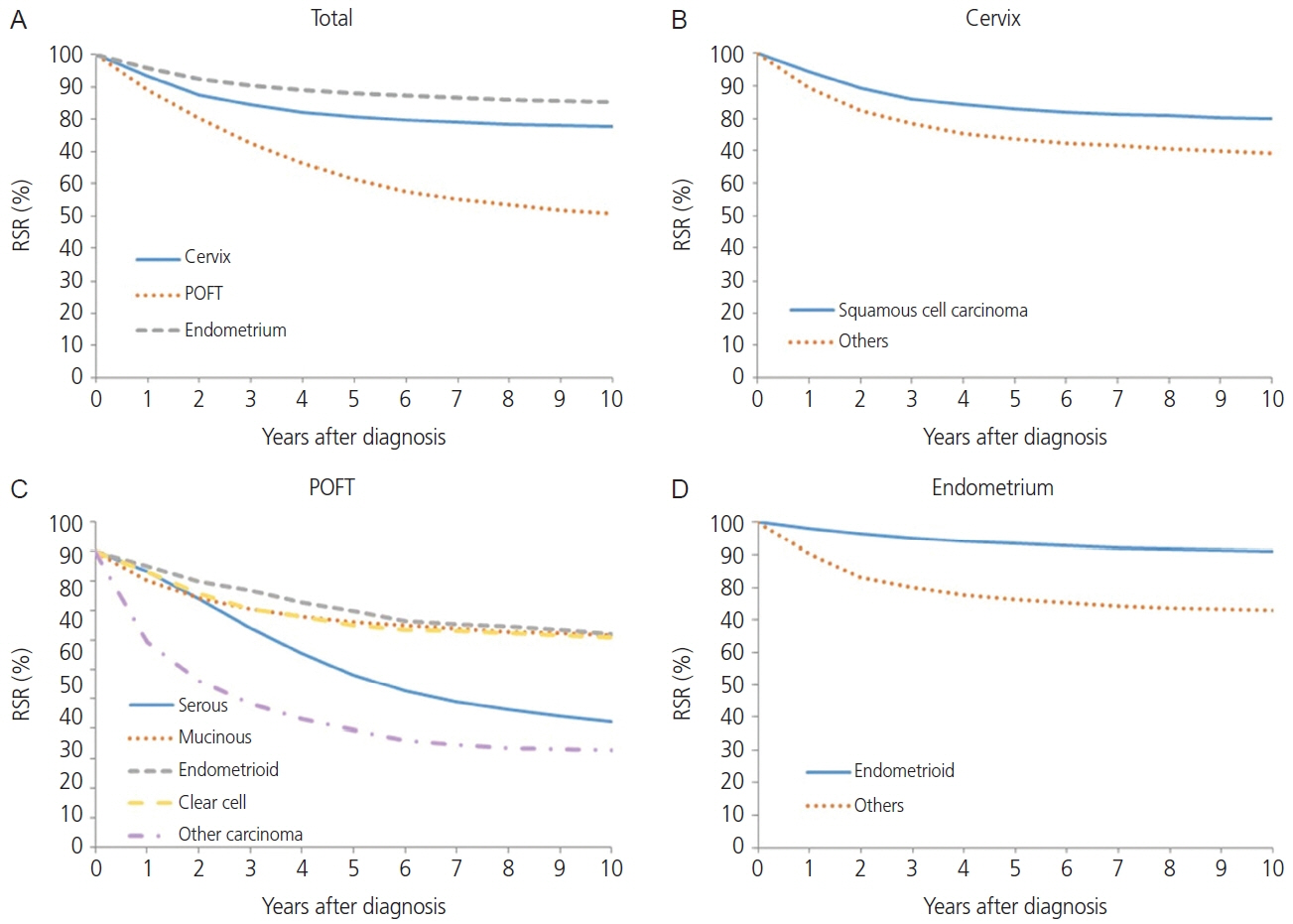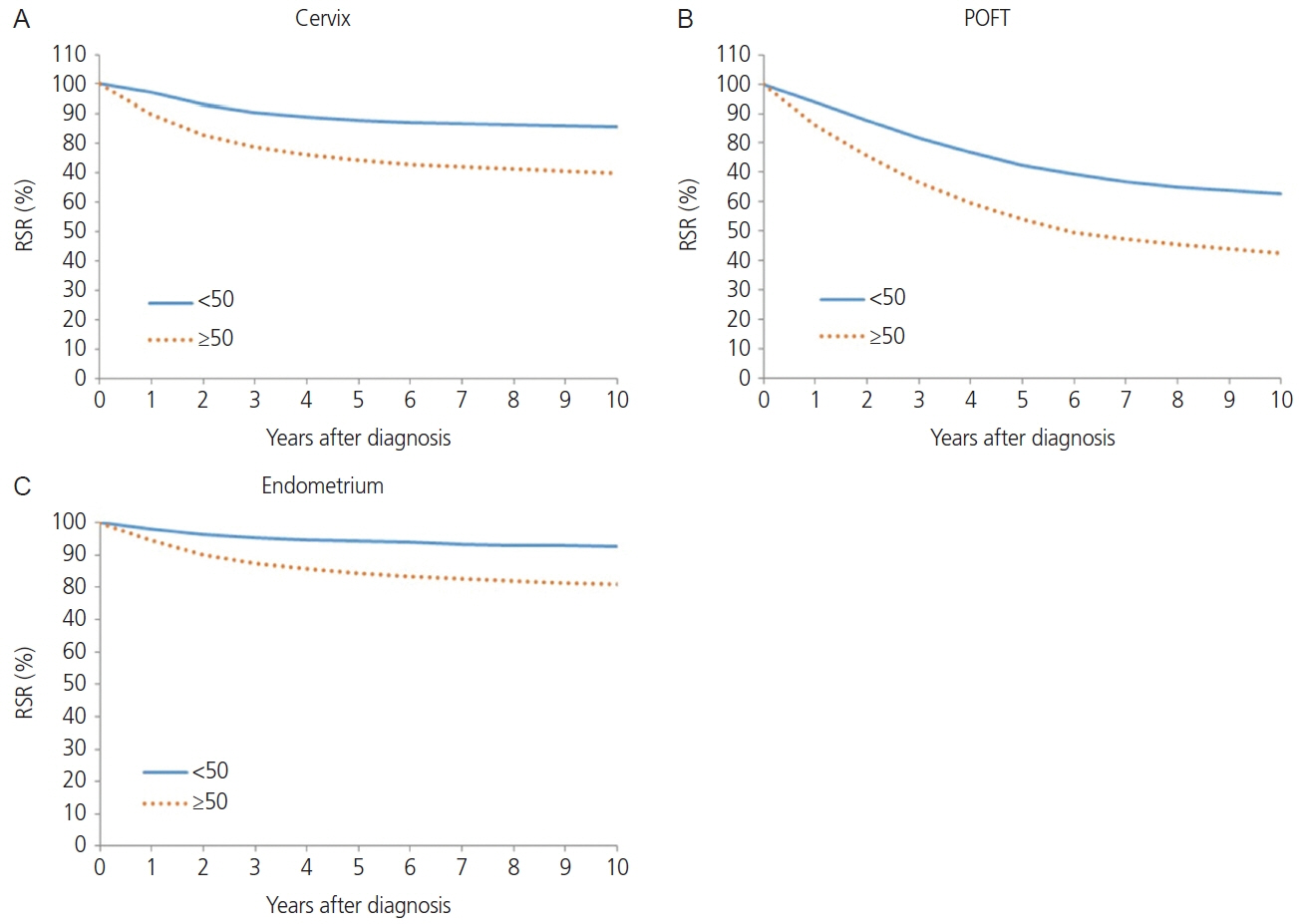The incidence and survival of cervical, ovarian, and endometrial cancer in Korea, 1999-2017: Korea Central Cancer Registry
- Affiliations
-
- 1Department of Obstetrics and Gynecology, Pusan National University Yangsan Hospital, Pusan National University School of Medicine, Yangsan, Korea
- 2Center for Gynecologic Cancer, Research Institute and Hospital, National Cancer Center, Goyang, Korea
- 3Department of Obstetrics and Gynecology, Korea University Ansan Hospital, Ansan, Korea
- 4Department of Obstetrics and Gynecology, Seoul National University College of Medicine, Seoul, Korea
- 5Division of Cancer Registration and Surveillance, National Cancer Control Institute, National Cancer Center, Goyang, Korea
- 6Department of Cancer Control and Population Health, National Cancer Center Graduate School of Cancer Science and Policy, Goyang, Korea
- 7Division of Tumor Immunology, Research Institute, National Cancer Center, Goyang, Korea
- KMID: 2520264
- DOI: http://doi.org/10.5468/ogs.21116
Abstract
Objective
The three major gynecologic cancers are cervical, endometrial, and ovarian cancer. This study aimed to describe the 19-year trends and survival rates in cervical, endometrial, and ovarian cancer in a Korean female population.
Methods
We searched the Korea Central Cancer Registry to identify patients with gynecologic cancer between 1999 and 2017. Age-standardized rates and annual percent changes were calculated. The relative survival rate (RSR) was reported by histology, age, and stage for each gynecological cancer.
Results
The total number of cervical, endometrial, primary peritoneal, ovarian epithelial, fallopian tube (POFT) cancer was 134,863, with the number of cases increasing every year: 6,077 in 1999 to 8,011 in 2017. The incidence of cervical cancer has decreased; however, that of POFT and endometrial cancer has increased. The 5-year RSR of cervical, POFT, and endometrial cancer was reported to be 80.8%, 61.4%, and 88.1%, respectively. In the case of cervical cancer, squamous cell carcinoma showed better survival than other histology (82.8% vs. 73.5%). Furthermore, in the case of endometrial cancer, endometrioid histology had substantially better 5-year RSR than the others (93.2% vs. 76.5%). Contrastingly, in the case of ovarian cancer, serous carcinoma had worse 5-year RSR than other types of histology.
Conclusion
The incidence rates for gynecologic cancers increased from 2005 to 2017, with an annual increase of 2.76 per year until 2017. Endometrial cancer had the highest RSR, while ovarian cancer had the lowest. Active cancer screening and the introduction of effective treatments might have contributed to the improved RSRs of gynecologic cancers.
Figure
Cited by 15 articles
-
Incidence and predictive factors for recurrent clear cell ovarian carcinoma: results from a single center in Thailand
Wikanda Hemman, Athithan Rattanaburi
Obstet Gynecol Sci. 2022;65(2):188-196. doi: 10.5468/ogs.21313.Gynecologic cancer clinical practice guidelines in Korea and current issues
Jeeyeon Kim, Joo-Hyuk Son, Tae-Wook Kong, Suk-Joon Chang
Korean J Women Health Nurs. 2022;28(2):83-86. doi: 10.4069/kjwhn.2022.05.10.Human papillomavirus genotype distribution in low-grade squamous intraepithelial lesion cytology, and its immediate risk for high-grade cervical lesion or cancer: a single-center, cross-sectional study
Nida Jareemit, Navin Horthongkham, Suwanit Therasakvichya, Boonlert Viriyapak, Perapong Inthasorn, Mongkol Benjapibal, Vuthinun Achariyapota, Irene Ruengkhachorn
Obstet Gynecol Sci. 2022;65(4):335-345. doi: 10.5468/ogs.22025.Multiple biomarkers are more accurate than a combination of carbohydrate antigen 125 and human epididymis protein 4 for ovarian cancer screening
Kyung Nam Kang, Eun Young Koh, Ji Young Jang, Chul Woo Kim
Obstet Gynecol Sci. 2022;65(4):346-354. doi: 10.5468/ogs.22017.Safety and feasibility of laterally extended endopelvic resection for sarcoma in the female genital tract: a prospective cohort study
Soo Jin Park, Junhwan Kim, Jae-Weon Kim, Hee Seung Kim, Ga Won Yim
Obstet Gynecol Sci. 2022;65(4):355-367. doi: 10.5468/ogs.22071.Indocyanine green fluorescent image-guided inguinal sentinel node biopsy for vulvar cancer: criteria and intraoperative challenges
Christos Iavazzo, Nikolaos Vrachnis, Ioannis D. Gkegkes
Obstet Gynecol Sci. 2022;65(5):483-484. doi: 10.5468/ogs.22027.Endometrial thickness and uterine artery Doppler parameters as soft markers for prediction of endometrial cancer in postmenopausal bleeding women: a cross-sectional study at tertiary referral hospitals from Vietnam
Phuc Nhon Nguyen, Van Tuan Nguyen
Obstet Gynecol Sci. 2022;65(5):430-440. doi: 10.5468/ogs.22053.Sentinel lymph node biopsy in high-risk endometrial cancer: performance, outcomes, and future avenues
Yoo-Na Kim, Young Tae Kim
Obstet Gynecol Sci. 2022;65(5):395-405. doi: 10.5468/ogs.22146.Factors associated with cervical cancer screening behaviors among young married female (aged 20–29) immigrants in South Korea
Sae Mi Park, Joo Won Lee, Yunhee Lee, Jun-Pyo Myong, Ha Kyun Chang, Kyung-Jin Min, Nak Woo Lee
Obstet Gynecol Sci. 2023;66(1):26-33. doi: 10.5468/ogs.22008.Diagnostic imaging of adnexal masses in pregnancy
Junhwan Kim, Jihye Lim, Jeong-Won Sohn, Seung Mi Lee, Maria Lee
Obstet Gynecol Sci. 2023;66(3):133-148. doi: 10.5468/ogs.22287.Evaluation of follow-up observation using human epididymis protein 4, a tumor marker, in patients with ovarian cancer
Masaya Uno, Rie Matsuo, Naoki Maezawa, Tomoyasu Kato
Obstet Gynecol Sci. 2023;66(4):290-299. doi: 10.5468/ogs.23024.Incidence and survival of gynecologic cancer including cervical, uterine, ovarian, vaginal, vulvar cancer and gestational trophoblastic neoplasia in Korea, 1999–2019: Korea Central Cancer Registry
Bo Seong Yun, Eun Hye Park, Johyun Ha, Jung-Yun Lee, Keun Ho Lee, Taek Sang Lee, Kyung Ju Lee, Young Ju Kim, Kyu-Won Jung, Ju-Won Roh
Obstet Gynecol Sci. 2023;66(6):545-561. doi: 10.5468/ogs.23208.A simplified two-marker immunohistochemistry strategy for Lynch syndrome screening in endometrial cancer patients
Ala Aiob, Yeo Rae Kim, Kidong Kim, Hyojin Kim, Yong Beom Kim, Duck Woo Kim, Jae Hong No, Soo Hyun Seo, Dong Hoon Suh, Kyoung Un Park
Obstet Gynecol Sci. 2023;66(6):537-544. doi: 10.5468/ogs.23124.Cervical cancer in Thailand: 2023 update
Mayuree Wongpratate, Sureewan Bumrungthai
Obstet Gynecol Sci. 2024;67(3):261-269. doi: 10.5468/ogs.23277.Navigating the thyroid-gynecologic interplay: a systematic review and meta-analysis
Heba Ramadan
Obstet Gynecol Sci. 2024;67(6):525-533. doi: 10.5468/ogs.24185.
Reference
-
References
1. Hong S, Won YJ, Park YR, Jung KW, Kong HJ, Lee ES. Cancer statistics in Korea: incidence, mortality, survival, and prevalence in 2017. Cancer Res Treat. 2020; 52:335–50.
Article2. Shin HR, Won YJ, Jung KW, Kong HJ, Yim SH, Lee JK, et al. Nationwide cancer incidence in Korea, 1999~2001; first result using the national cancer incidence database. Cancer Res Treat. 2005; 37:325–31.
Article3. Chung HH, Jang MJ, Jung KW, Won YJ, Shin HR, Kim JW, et al. Cervical cancer incidence and survival in Korea: 1993-2002. Int J Gynecol Cancer. 2006; 16:1833–8.
Article4. Chung HH, Hwang SY, Jung KW, Won YJ, Shin HR, Kim JW, et al. Ovarian cancer incidence and survival in Korea: 1993-2002. Int J Gynecol Cancer. 2007; 17:595–600.
Article5. Jung KW, Won YJ, Kong HJ, Lee ES. Cancer statistics in Korea: incidence, mortality, survival, and prevalence in 2016. Cancer Res Treat. 2019; 51:417–30.
Article6. World Health Organization. International statistical classification of diseases and related health problems. 10th ed. Geneva: World Health Organization Press;1994.7. Segi M, Fujisaku S. Cancer mortality for selected sites in 24 countries (1950-1957). Sendai: Tohoku University School of Medicine;1960.8. National Cancer Institute. SEER Summary staging manual 2000: codes and coding instructions. Bethesda: National Cancer Institute;2000.9. Ederer F, Heise H. Instructions to IBM 650 programmers in processing survival computations. Bethesda: National Cancer Institute;1959.10. Oh CM, Jung KW, Won YJ, Shin A, Kong HJ, Jun JK, et al. Trends in the incidence of in situ and invasive cervical cancer by age group and histological type in Korea from 1993 to 2009. PLoS One. 2013; 8:e72012.
Article11. Lim MC, Moon EK, Shin A, Jung KW, Won YJ, Seo SS, et al. Incidence of cervical, endometrial, and ovarian cancer in Korea, 1999-2010. J Gynecol Oncol. 2013; 24:298–302.
Article12. Patel A, Galaal K, Burnley C, Faulkner K, Martin-Hirsch P, Bland MJ, et al. Cervical cancer incidence in young women: a historical and geographic controlled UK regional population study. Br J Cancer. 2012; 106:1753–9.
Article13. Kim CJ, Kim BG, Kim SC, Kim YT, Kim YM, Park SY, et al. Sexual behavior of Korean young women: preliminary study for the introducing of HPV prophylactic vaccine. Korean J Gynecol Oncol. 2007; 18:209–18.
Article14. Kim YT. Current status of cervical cancer and HPV infection in Korea. J Gynecol Oncol. 2009; 20:1–7.
Article15. Hunn J, Rodriguez GC. Ovarian cancer: etiology, risk factors, and epidemiology. Clin Obstet Gynecol. 2012; 55:3–23.16. Calle EE, Rodriguez C, Walker-Thurmond K, Thun MJ. Overweight, obesity, and mortality from cancer in a prospectively studied cohort of U.S. adults. N Engl J Med. 2003; 348:1625–38.
Article17. Lee JY, Kim S, Kim YT, Lim MC, Lee B, Jung KW, et al. Changes in ovarian cancer survival during the 20 years before the era of targeted therapy. BMC Cancer. 2018; 18:601.
Article18. Kim SI, Lim MC, Lim J, Won YJ, Seo SS, Kang S, et al. Incidence of epithelial ovarian cancer according to histologic subtypes in Korea, 1999 to 2012. J Gynecol Oncol. 2016; 27:e5.
Article19. Baik I. Forecasting obesity prevalence in Korean adults for the years 2020 and 2030 by the analysis of contributing factors. Nutr Res Pract. 2018; 12:251–7.
Article20. Wise MR, Jordan V, Lagas A, Showell M, Wong N, Lensen S, et al. Obesity and endometrial hyperplasia and cancer in premenopausal women: a systematic review. Am J Obstet Gynecol. 2016; 214:689.e1-17.21. Sung H, Siegel RL, Rosenberg PS, Jemal A. Emerging cancer trends among young adults in the USA: analysis of a population-based cancer registry. Lancet Public Health. 2019; 4:e137–47.
Article22. Lee DY, Lee TS. Associations between metabolic syndrome and gynecologic cancer. Obstet Gynecol Sci. 2020; 63:215–24.
Article23. Song JE, Ahn JA, Lee SK, Roh EH. Factors related to low birth rate among married women in Korea. PLoS One. 2018; 13:e0194597.
Article24. Raglan O, Kalliala I, Markozannes G, Cividini S, Gunter MJ, Nautiyal J, et al. Risk factors for endometrial cancer: an umbrella review of the literature. Int J Cancer. 2019; 145:1719–30.
Article25. Park HJ, Hong YH, Cho YJ, Lee JE, Yun JM, Kwon H, et al. Trends and cut-point changes in obesity parameters by age groups considering metabolic syndrome. J Korean Med Sci. 2018; 33:e47.
Article26. Bjørge T, Engeland A, Tretli S, Weiderpass E. Body size in relation to cancer of the uterine corpus in 1 million Norwegian women. Int J Cancer. 2007; 120:378–83.
Article27. Parsons LHP, Pedersen R, Richardson DL, Kho KA. The prevalence of occult endometrial cancer in women undergoing hysterectomy for benign indications. Eur J Obstet Gynecol Reprod Biol. 2018; 223:108–12.
Article28. Desai VB, Wright JD, Gross CP, Lin H, Boscoe FP, Hutchison LM, et al. Prevalence, characteristics, and risk factors of occult uterine cancer in presumed benign hysterectomy. Am J Obstet Gynecol. 2019; 221:39.e1-14.
Article29. Frost JA, Webster KE, Bryant A, Morrison J. Lymphadenectomy for the management of endometrial cancer. Cochrane Database Syst Rev. 2017; 10:CD007585.
Article
- Full Text Links
- Actions
-
Cited
- CITED
-
- Close
- Share
- Similar articles
-
- Correction of Funding information: The incidence and survival of cervical, ovarian, and endometrial cancer in Korea, 1999-2017: Korea Central Cancer Registry
- Incidence of cervical, endometrial, and ovarian cancer in Korea, 1999-2010
- Incidence and treatment outcomes of ovarian carcinosarcoma from the national cancer registry of Korea
- Incidence of cervical, endometrial, and ovarian cancer in Korea during 1999–2015
- Current status of gynecologic cancer in Japan





